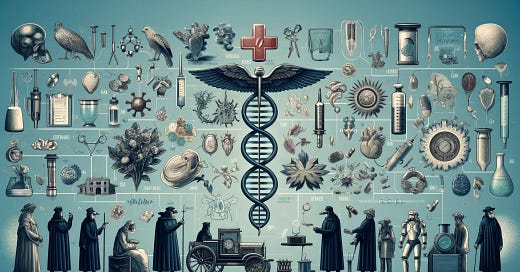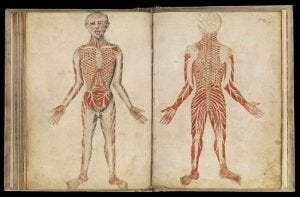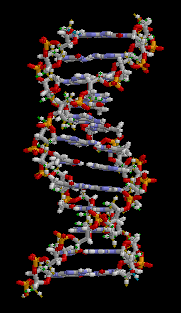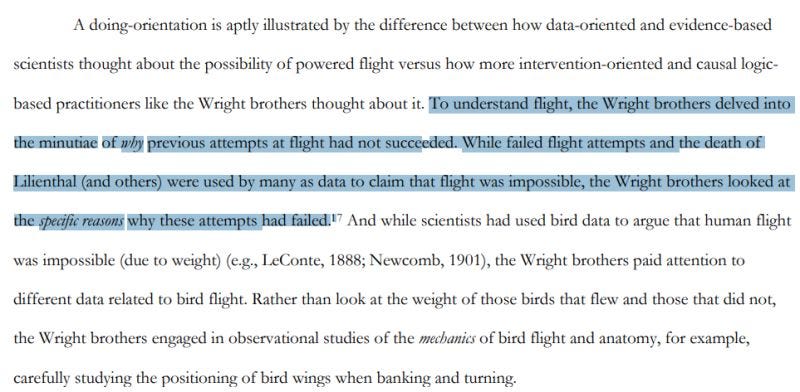#221: Staying Alive! A Journey Through A Healthcare Innovation Timeline
Challenging wisdom, discovery, and being wrong - the history of medical science.
There’s a meme that often pops up online about the anthropologist Margaret Mead - who was asked about the first signs of civilisation. And her answer is reported to have been the discovery of a healed femur bone dating back some 13,000 years. The healing of the bone suggests that it was looked after and that in turn meant the sign of some kind of social bond rather than the survival of the fittest credo that would have been the basis of human existence at the time. It’s also an interesting aside that the history of civilisation is the history of care.
As you can well imagine, there would have been a huge prevalence of witch-doctors, shamans, and miracle men in the very early days of civilisation - in short, people dealing with magic and the occult, and very little science. It was only with the arrival of Hippocrates that we associate the start of modern medicine. Born in Kos about 460 years BCE, he brought rationality into medicine, moving it away from the domain of religion and superstition. He argued for natural causes, diets, and living habits, and recommended clinical observation and categorisation of diseases, giving his name to the oath that every doctor takes to this day, since it was thanks to him that medicine became a profession. And yet Hippocrates was wrong about so many things! His view was based on humoral theory - which suggests that diseases are caused by the imbalance in and amongst the 4 bodily fluids - blood, phlegm, yellow bile, and black bile.
500 years later, Galen, a Greek scientist, further evolved the humoral theory, but his key contribution was to bring the study of anatomy into medicine, building on earlier work by Herophilus and Erasistratus. Galen created detailed drawings like these about the insides of humans. But he too, also believed in the 4 humors.
For the next key moment in the history of medicine, and getting beyond humoral theory, we have to go past the dark ages to the edge of the renaissance. Paracelcus, a Swiss physician in the 15th century rejected humorism in favour of chemistry. Paracelsus championed the use of compounds like iron, sulphur, mercury, and lead and chemistry principles and processes. He named the element Zinc, and his thinking was the precursor of terms like Alkali, and the use of analgesics (tincture of opium), and he’s said to have separated the fields of surgery, medicine, and pharmacy. He even theorised about the role of microbes, though he didn’t discover them.
In the 1860s, Louis Pasteur (and others) developed germ theory and immunization, pushing medicine into microbiology. Within a few decades, Rontgen discovered X-Rays while conducting experiments with electricity and cathode tubes. You might say this allowed medicine to enter the realm of physics. Over the next century, cardiograms, MRI scans, and CT scanners would bring physics and and medicine ever closer.
In the 20th century, we saw the discovery of antibiotics and insulin, but the single stand out discovery of the century was, of course, DNA and the double-helix. Watson and Crick are credited with this but their work was underpinned by the crystallography expertise of Rosamund Franklin. Medicine had finally reached the information era.
That path leads us to the invention of CRISPR for gene editing in 2012. The magnitude of this is hard to overstate as it pretty much the first time humans get to play god by actually modifying genetic structure. This is also the tipping point from where we can’t always tell the long term implications of our choices, and where futurology and philosophy become a part of medical science. And in 2021, Alpha Fold from Deep Mind starts predicting the thousands of 3D structures of proteins just by their amino acid sequence information, which enables better prediction of functionality.
As you read this today, medical science and healthcare is changing faster than ever before - from miniaturisation of equipment (hand held ultrasounds), to tackling cancer with stem cell research. Whether we are better understanding the inner working of the brain, or predicting alzheimers and dementia, through to growing auxiliary organs inside the body, we’re definitely in science fiction territory. We are arguably in the single most transformative decade of healthcare in history.
This timeline of course follows a largely western view point - and there were many parallel evolutions in China, India, and the middle east - across health, medicine, and curative substances. But the timeline here is just illustrative. Take a step back and a few interesting things will come into focus.
Beyond Wisdom: Every person in our list who has pushed the boundaries of knowledge has done so by rejecting received knowledge in favour of observation and real world experience (as have the hundreds we haven’t mentioned). This is not easy to do, but is true for almost every innovator in history irrespective of their fields, or organisation, and whether the innovation is marginal or disruptive. The following extract explains this in the context of the invention of flight.
Being Committed: Despite the obvious shortcomings of limited knowledge, and also limited success, at every point in history, doctors have acted to cure people and solve problems. The lack of results, data, or understanding didn’t prevent them from trying based on their available knowledge. We always have to act on available knowledge and not be paralysed by ignorance. If you think about it, this is how agile development works and is also the principle of ‘strong opinions, loosely held’.
Being Wrong: it’s amazing that at each stage of this journey through the evolution of healthcare, the best minds of the time have believed that they were right, when in fact they were completely wrong. Which should make us pause for a second to reflect on the probability that a lot of things we believe deeply might prove to be highly fallible theories in the harsh glare of future discoveries. It was only a couple of hundred years ago, that leeches were applied to patients for blood letting, which was seen as a cure-all for a variety of diseases.
Facing Backlash: When you break the rules, reject received wisdom, and try and make a new path, there’s usually a long queue of people telling you that you’re wrong. Often the backlash is from your own community or cohort, and the key people who you need to first convince about your new path. Ignaz Semmelweiss introduced antiseptic processes and handwashing, but his ideas were rejected leading to his having a mental breakdown. Edward Jenner faced verbal and physical attacks for trying to immunize people to smallpox via cowpox lesions. John Snow helped us understand that cholera spreads through water, but the prevalent theory of miasma (airborne causes) had many supporters and his ideas were dismised. Barry Marshall had to self-ingest H.pylori bacteria to prove that stomach ulcers were caused by bacteria - because he was ridiculed for his ideas.
Tools and technology. The printing press allowed text books such The De Humani Corporis Fabrica illustrated anatomy to be widely read. The invention of compound microscopes in the 1590s opened the microscopic biological world to observation. The combination of X-Rays, vacuum tubes, and photographic plates and film allowed Rosalind Franklin’s famous ‘Photo 51’ which revealed the helical structure of DNA. Along the way the thermometer, the stethoscope, and vaccination all enabled better observation, more data, and deeper analysis. New science creates new tools, which allow for deeper observation or better outcomes. New discoveries follow because we are able to access and use new tools. And every new tool and technology opens another door of discovery.
Keep challenging!
AI Reading
AI Ophthalmology: According to this paper, GPT4 is approaching the performance levels of specialist ophthalmologists in diagnostic capability, and is already better than junior or non-specialist doctors. One of the ways to use this tech is to actually help assess and benchmark human capability. (PLOS / FT)
MatterGen: Microsoft announces MatterGen - a generative AI model dedicated to the science of property guided materials design. It gives you the ability to say design a product with specific conductive and tensile properties for example. (Microsoft/ Turing Institute)
Image to Video: Microsoft also introduced VASA - a particularly good image to video tool which raises the spectre of home made deepfakes. (Microsoft)
Higher AI: can AI make us wiser? I’ve often pondered whether AI can create a ‘truth engine’ but in this article, the author wonders whether it can at least make wiser recommendations. (Medium)
AI Productivity: Here are a few ways AI could make office work more productive, but my favourite is always about making meetings better! (WSJ)
Electricity Bottleneck: could the next bottleneck for AI be the availability of cost effective electricity? This article explores the ideas (FT)
Future of chat GPT - And here’s an interview with the CTO of Open AI, talking about the future of ChatGPT (WSJ)
2D → 3D: InstantMesh turns any 2D into a 3D image in seconds. I’m sure there are great use cases, but also, this is very cool! (Decoder)
Other Reading
Working memory/ neuroscience - how do we remember things? Short term? Long term? Very short term? Working memory is about things we need to remember only for a few seconds. Working memory is susceptible to ‘interference’ - distraction distorts working memory. What’s the brain activity when working memory is being used? This is addressed 13 mins into the podcast on Nature. Different sets of neurons are used for memory vs retention. Useful for Alzheimers for example. (Nature Podcast)
Quantum: A illuminating piece in the McKinsey Quarterly about quantum computing investments and the story they tell of scale ups and mainstreaming of the technology. (McKinsey)
Transformations that work - This article about successful transformations resonated a lot with something I’ve always believed in - transformation is business as usual. It’s a continuous effort and as the piece says, it needs to be built into the “companies’ operating rhythm”. I’ve called this the ‘Evolving Operating Model’ before. The piece talks about other areas as well, such as using the middle management, and accessing external capital early. (HBR)
Kareem Abdul Jabbar: I was delighted to discover that post his glorious NBA Career, Kareem Abdul Jabbar is a writer and activist of some depth. Always impressed by people who have multiple strings to their bow.
Marathon:
Last week was also the TCS London Marathon, and thanks to our sponsorship, I was privileged to be at the finish line hospitality. Running a marathon is such an incredible achievement and I took these photographs of finishers (none of whom I know by the way) as they got to within 20 yards of the finish line. Look at their faces. Thats what its all about!

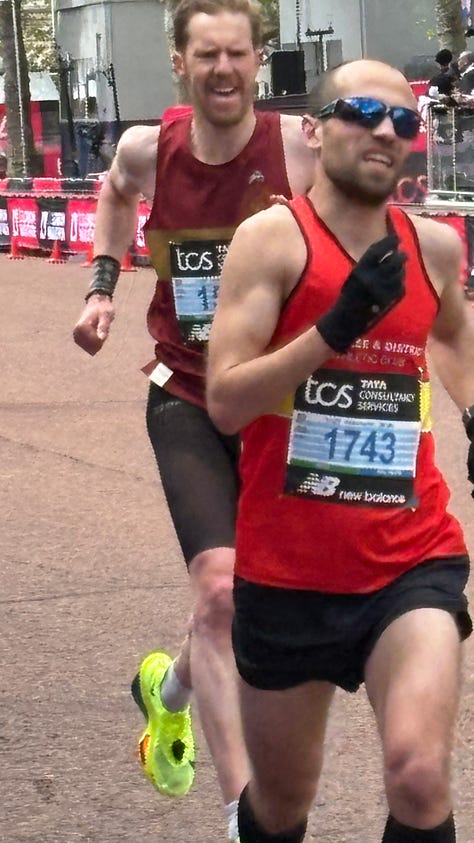
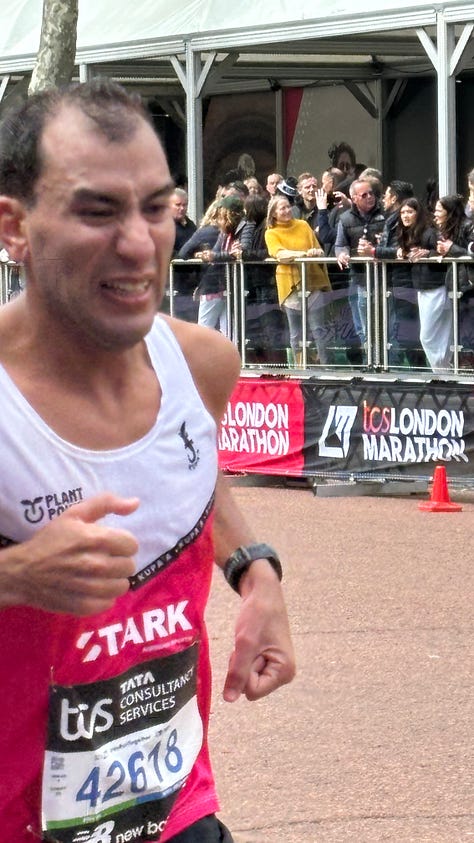
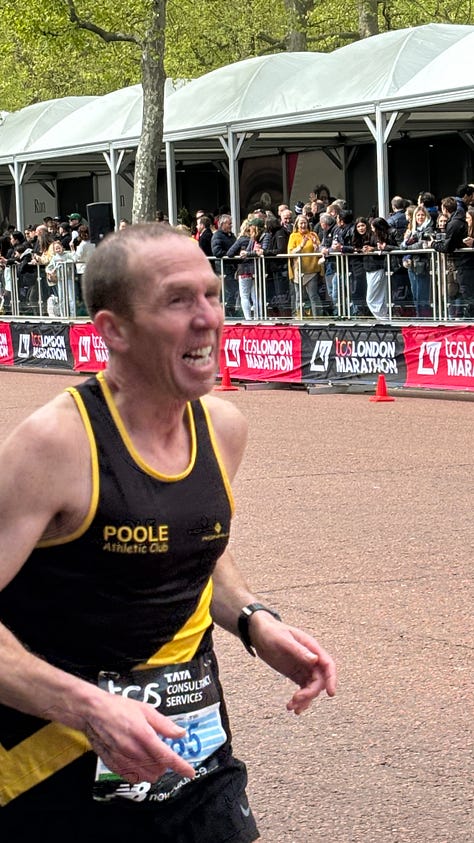




Thanks for reading and see you next week.

